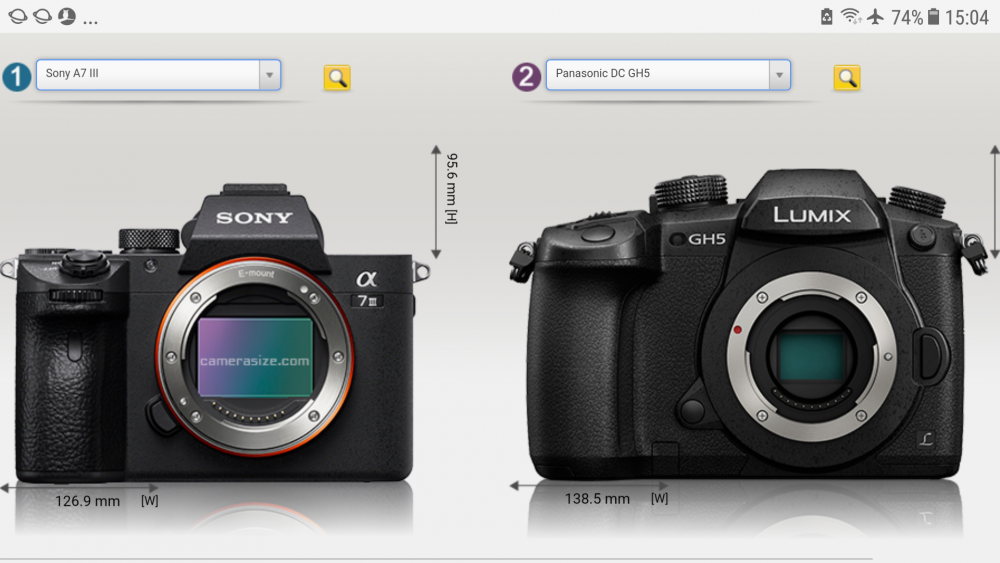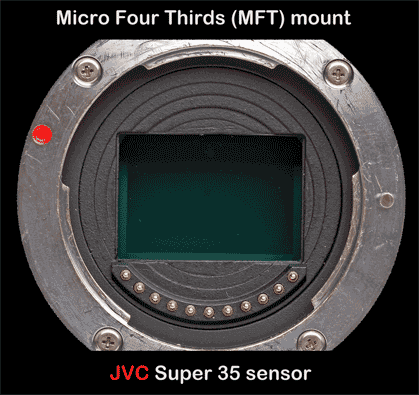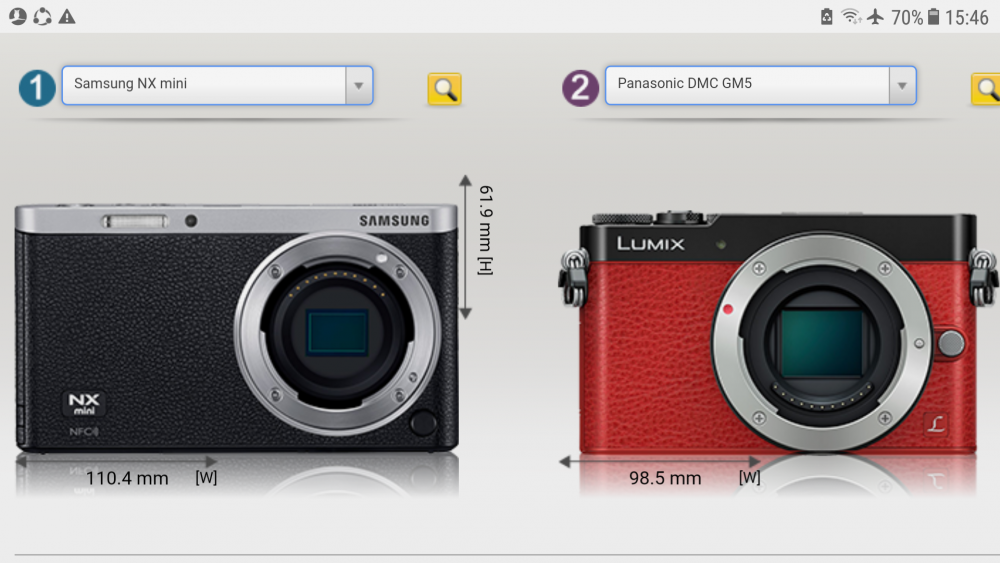-
Posts
2,531 -
Joined
-
Last visited
Content Type
Profiles
Forums
Articles
Everything posted by sanveer
-
I don't know Why, but I have an l16 Light Camera kind of feeling about this. Grossly over-hyped. It may have an interesting 3D screen, but in my guess, it won't change the course of smartphones. Also the camera modules will push it into the highend FF Price range. And would it be truly pocketable afttgr that. There is a HUGE need for way better photos from smartphones (and everything else pocketable). Though it should be pocketable, nd it should cost an arm and a leg. With a processor (SoC) that is 2-3 generations behind other Flagships, when it is finally released.
-
Or the main body has the writing being done, and it also has the battery (apart from some commin controls between the 2 drone types, someone had swapped the cameras and they seemed to work pretty well). Think of it like the 10-bit 4-2-2 writing via the HDMI/ type-C that the new Full Frame Mirrorless Cameras seem to be offering. Even some LEDs have it (like a control panel Away from the light structure, instead of embedded at the back of the light structure, to help heat dissipation).
-
I am suddenly wondering why can't everyone can offer 10-bit 4-2-2 internally if the tiny Mavic 2 Pro can. That camera looks 1/3rd-1/4th the size of the various mirrorless ILCs being announced, using MicroSD cards (instead of XQD, CFast or and full sized SD Cards), and Many other size limitations. It's sensor is obviously much smaller, but so are other factors on that one. If Panasonic can get PDAF, theoretically, it can beat almost every FF out there, as a complete package.
-
I saw the review on dpreview (on their YouTube channel), along with the mini comparison with the GH5. The shadow recovery and colour correction seems difficult in post (in comparison). The 10-bit internal is 4-2-0 of the Fuji. It seems very strange to put it politely. The Autofocus had improved vastly. And face tracking in video seems almost as good as Sony (it seems yo have similar 495 autofocus points as the Sony, incidentally).
-
Huge crop and slow photo shooting Rates. It's like a recycle of old Canon parts in a new Mount.
-

Panasonic announcing a full frame camera on Sept. 25???
sanveer replied to Trek of Joy's topic in Cameras
Hahahahahahahahahahahahahhahahahahahahahahahahaha Frakin Hilarious. Panasonic should feel ashamed. They're generating more hype than Smartphone Flagship Launches. -

Panasonic announcing a full frame camera on Sept. 25???
sanveer replied to Trek of Joy's topic in Cameras
There are Many things you haven't heard of. That's why you aren't called the Oracle. This is not a rumour. I Know people who have bought fake Nikon cameras. I haven't bought a Nikon or Canon in ages, so it didn't happen with me. Do an online search before you attempt to call someone's information fake. You would look less misinformed and arrogant. -
It seems like Canon and Nikon are secretly working together.
-

Panasonic announcing a full frame camera on Sept. 25???
sanveer replied to Trek of Joy's topic in Cameras
Wow. I am just a little worried about Panasonic's claimed International Warranty (I had a terrible experience after picking up a GX85 from Australia when there were some quality control issues that Panasonic was unable to solve DESPITE sending it for servicing across 2 continents). Otherwise it seems pretty cheap to fly down and pick a few GH5. -

Panasonic announcing a full frame camera on Sept. 25???
sanveer replied to Trek of Joy's topic in Cameras
I am sure some people may disagree, but IMHO the majority of Panasonic woes wrt to sales have been due to Bad Marketing and After Sales. And with the LX100 ii, not listening to customers' feedback. If the rumours about the GH and GX line were true, there would be no LX100 ii. The link shared (https://lumix.panasonic.eu/photokina-en/) seems to imply that 4 new cameras are going to be released at Photokina, so the GX and GH line-up being the sole cameras for the future also seem to make no sense. Panasonic needs a Completely New Marketing and Advertisment Team. Also, their after sales is very disappointing. Their distribution has improved substantially, but there is still a lot of scope in that area. -

Panasonic announcing a full frame camera on Sept. 25???
sanveer replied to Trek of Joy's topic in Cameras
I thought about it. If Panasonic actually introduced a Full Frame ILC (instead of this new FF Varicam), it would crash their M43 Market. Users would panic and wonder whether Panasonic has moved to a different format. Rumours alone would make it lose market share big time. Has it been at that price for a long time, or only recently. In Nikon or even Canon, if prices are unusually low, then it means that those are fake products. They do work and have most of the features of the original product. They sometimes exhibit more noise and may not be able to shoot at the full mentioned frame rate. Or maybe the pics are 12-bit instead of 14-bit. -
The 1st file has a Crop wrt to the 2nd one.
-
Could you share some link to this fact about the fov being the same for 8-bit and 10-bit. I could be wrong, but all documentation so far, proves things otherwise.
-

Panasonic announcing a full frame camera on Sept. 25???
sanveer replied to Trek of Joy's topic in Cameras
Apart from PDAF, they could easily handle everything else. Maybe they will use the Olympus full frame lenses that Olympus has been patiently patenting over the last 5 years. Or get Sigma to design cheaper Leica Mount lenses for them. It seems too speculative. More than anything I am curious to know how M43 users feel about the apparent rumour. -

Panasonic announcing a full frame camera on Sept. 25???
sanveer replied to Trek of Joy's topic in Cameras
They won't be able to do it in Anything EXCEPT a cinema camera. An 8k Varicam. -

Panasonic announcing a full frame camera on Sept. 25???
sanveer replied to Trek of Joy's topic in Cameras
Actually I think the rumour may be correct. Only that it will be a Cinema Camera like the Varicam with a Full Frame sized sensor (larger than the sensor on the Varicam). It won't be a consumer camera. Right now Panasonic has too many issued with getting a FF Consumer/ Prosumer Camera: 1. Lack of PDAF. It can't use its DFD for Full Frame. 2. No FF lenses yet. If it uses the Leica Mount, it will have to create affordable lenses and a lot more than those currently on offer. There are Many other things it needs to do too. -
In Dual Native ISO cameras, the higher native ISO always has More noise. Check the video embedded below. https://www.newsshooter.com/2018/08/28/kinefinity-mavo-lf-dual-native-iso-birtv-2018/
-
"What is the difference between Full FOV mode and HQ mode under Mavic 2 Pro’s 4K resolution? Full FOV down samples from the 5.5K sensor to 4K resolution while HQ crops in the center for finer image quality but less FOV. Full FOV view is 75° and HQ view is 55°. You can select between them according to your actual shooting demands.." From the FAQ sector on DJI's site. https://m.dji.com/product/mavic-2 Sounds very unusual. Not because it wouldn't seem possible, but because DJI is then releasing a half finished product. But apparently the Mavic 2 is getting a new controller woth a build in LCD Screen, so there is a small likelihood that this may be possible.
-
The Mavic 2 Pro photos and Video have a strange colour cast. Apart from the 10-bit video, if the Mavic 2 Pro doesn't have sharpness, details and dynamic range advantages over the Mavic Pro and Phantom 4 Pro, it would mean the Hasselblad association hasn't really yielded any positive results. Obviously the Hasselblad collaboration is most likely only in name, with most likely only the colour science and some aspects of the image (such as the the highlight rolloff) proof of Hasselblad's involvement. But either ways, if what you're a suggesting is true, then it doesn't hold good for Hasselblad.
-
Wow. That's amazing news. Would that also involve the video side of things (apart from optics and lenses)? I have always felt that Olympus could do way better in their video department, especially since they have no higher end cinema line to protect (even without using ProRes or RAW). Also, M43 could do with more competition in the video department I guess.
-
I wonder whether the video from the Mavic 2 Pro has Very little sharpening in video, which may require some sharpening in post. It does downscale 8.3MP from 14.2856 MP (instead of from 20MP), but I suspect that may not be the problem. I guess the issues needs to be thoroughly investigated. I saw this, and apparently 4k on the Phantom 4 Pro isn't reading the entire sensor either. A crop factor may not be telling the entire story. https://forum.dji.com/thread-112902-2-1.html#post_984777
-
Yes and no. Yes, because the imagine circle (the circumference of M43 lenses is way lesser than full frame for Most lenses, Despite similar mount circumference). Everyone can do with a bigger sensor or way better processing or both. Actually, right now there are quite a few issues with the sensor size, optics (lenses and glass mostly), photo formats and computational photography which make it impossible (atleast for the moment) for smaller sensors to replace larger sensors. There are larger sensors that do faster frame rates, and yes atleast theoretically, smaller sensors should have faster readout speeds. 1) Most Flagships have better dynamic range through HDR, and yes, the Pixel 2 is probably the leader of the wolf pack. 2) Just as dynamic range can be improved by stacking, so can low light. 3) If you mean lower or higher exposure by stacking, perhaps. That's is possible even without it. Though I wonder how accurate things like exposure or white balance consistency would be. 4) Some guys seem to be doing it, but nobody seems to be doing it extremely well (except ILCs, which do it with cameras set on tripods to enable perfect sticking with no shame of any kind hampering stiching). This has multi-frame and not multi-exposure doing the magic work. Actually the Pixel and the P20 Pro have shown that there is hope for computational photography, but at the moment there are a few limitations that need to be addressed first. The most important ones are processing power, the sensor's maximum readout speed, photo format and optics. The l16 is proof of the fact that many of these are easier with a single sensor than with multiple ones. And corner softness is a huge issue, as are other issues with stitching of multiple smaller photos to create one large photo. The Pixels secret sauce is actually a copy of Panasonic's Pre Burst IN 4K Mode. It starts shooting pics way before you actually press the shutter, thereby saving time and having the ability to atck more photos. Most of these smaller sensors can do full Res 10-bit or 12-bit at 25-40 frames per second. If they were able to do between 60 and 120 f4ames at full res, and if had the processing power to shoot (and stack) these pics in RAW, it would be way better than what we get now. I guess there is no really consumer processing of RAW photos, especially on smartphones (which I believe is not due to processing power limitations or writing speeds or pipeline issues). So stable photos are usually just 8-bit JPEGs. There is HEIF/ HEIV photos in 10-bit, but their quality iand implementation is still very early stage and there is hardly anyone adopting the format, right now (except for Apple in the iPhone X, which has some serious glitches, which need to be ironed out). Unfortunately 8-bit JPEGs whether they have 12 stops or 14 stops (like in the Mavic 2 Pro), will bot be replacing professional camera photos shot on 12 and 14-bit RAW, anytime soon. There are some major issues with optics, cross talk and colour information and other issues with small sensors and cameras, which experts (like those on the l16 light camera) are genuinely ignorant of, and that smartphone companies (like Google for the Pixel cameras) conviently doesn't discuss. I have high hopes from the new Sony 48MP IMX586 Sensor. But, I also realise that processing such large photos and having phoyo stacking on such an enormous resolution sensor is probably too challenging for any present processor (regardless of the number of additional ISPs onboard). Plus the optics would always be a compromise, especially all the plastic ones. I don't see Computational Photography assisted photos from small/ tiny sensor competing with photos from M43 and larger cameras anytime soon. I would actually believe that it may take ATLEAST 5 years more, on a very conservative estimate. It's not that the tech isn't there, it's just that nobody really wants to Genuinely Disrupt the ILC and Professional Photography and Videography market anytime soon. Especially at this side of the $1000 price range.
-
The mount size difference between full frame and M43 is actually pretty small (it seems to be a phenomenon endemic to all ILCs, since even the tiny 1inch sensor sensor, the Samsung NX1 has a much larger mount to the size of the sensor). I also noticed that M43 contact points for lenses are further away from the rim of the mount, closer towards the sensor (and apparently 11, instead of the 10 appears on the Sony FF sensors). Panasonic could push the contact point at the very corner, a few more millimetres closer to the rim of the mount, for accommodating a larger sensor (and maybe introduce a new lens lineup). I am guessing, therefore, that not only can an APS-C size sensor fit on M43 size mount camera (like the JVC LS300), but something much closer to a Full Frame sensor, could, as well. Though, how the lenses handle such a large sensor, would need to be tested. I therefore think Panasonic should explore the possibility of putting a sensor larger than APS-C in a camera that does not have IBIS (like the GM Series and the GH5s), with higher usable ISO. It could have two versions, one with much higher pixel count (24-28MP), and the other with much larger pixels (12-18MP with pixels larger than the ones on the GH5s). It seems quite doable. If they could adapt the present M43 lenses, it would be amazing. What it definitely needs to have is PDAF (especially for high speed photography and continuous autofocus in video), 14-bit colour and a little more innovation (15-20 fps for sports photography, a new Log Profile since the old VLog is taking away dynamic range from the sensor's full capacity. They should price it at $2000, targeting both the A7iii and the A7s series. http://j.mp/2MXuZ03
-
I have had issues with a few Panasonic products (the GX85, 25mm f1.7 lens, etc), and with products form other manufacturers. It happens all the time. Quality control doesn't mean all products are perfect. Ken Booth can just send the product back for repair or replacement. Was the Parrot Anafi or the Autel Evo that has a camera that leaned towards one side. And there are hundreds, if not thousands of products with that curious glitch. It's not something that can be ignored. But the number of people affected by the issue will determine whether it's a one off, or a glitch epidemic. Except that his numbers are more conservative than DXO Mark labs, that rates the same sensor for about 12.5 stops.
-
ONLY in HDR mode. Otherwise it has the same dynamic range that the Phantom 4 Pro probably has. But less noisy shadow and better highlight rolloff. So better image. According to Ming Thein it had between 11.5-12 stops: "...At base ISO, we have a solid 11.5-12 stops of usable DR; a bit more if you are careful with exposure and post processing. This is a noticeable improvement over the original Mavic, and given the way highlight rolloff has been tuned, quite close to what M4/3 delivers in practice. ..." https://blog.mingthein.com/2018/08/24/2018-dji-mavic-2-pro-review/#more-17580






